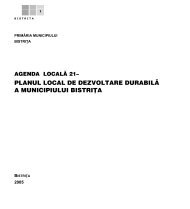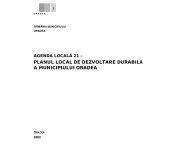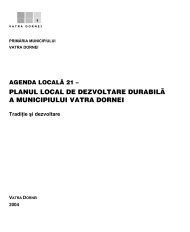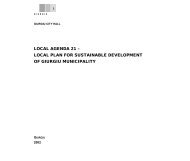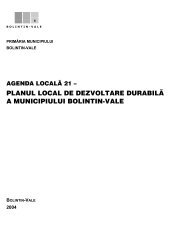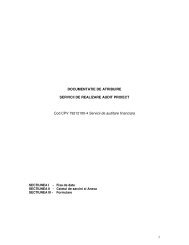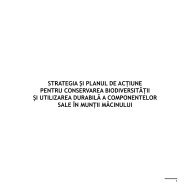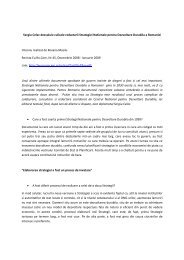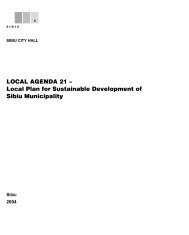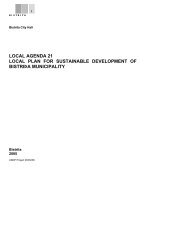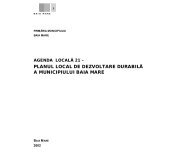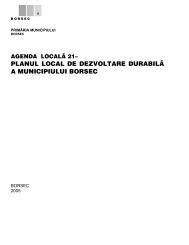English Version - United Nations Development Programme Romania
English Version - United Nations Development Programme Romania
English Version - United Nations Development Programme Romania
You also want an ePaper? Increase the reach of your titles
YUMPU automatically turns print PDFs into web optimized ePapers that Google loves.
When analysing the solutions for the electric and thermal power industry, the potential impact of<br />
these solutions on the environment should be taken into consideration.<br />
Promoting and stimulating the generation of power from renewable resources.<br />
Having in view the possibility of obtaining electric and thermal power through the burning of waste<br />
materials, an analysis must be made of the effects on the reduction of pollution, in concurrence with<br />
municipal management policies.<br />
d) Energy usage<br />
CURRENT STATE OF AFFAIRS<br />
Regarding the production of primary power resources, <strong>Romania</strong> depends on import for over<br />
36% of them. As compared to other E.U. countries, for example Austria, Belgium, etc., that have to<br />
import over 50% of their primary power resources, <strong>Romania</strong> has a lower dependency rate. At present, the<br />
import of power resources constitutes a financial burden of $2.2 billion US for <strong>Romania</strong>.<br />
Since in 1998 <strong>Romania</strong> was highly dependent on imports of methane gas, oil and oil products<br />
(that represent over 80% of total imports) <strong>Romania</strong> needs to diversify its suppliers, especially those that<br />
supply methane gas. Presently, <strong>Romania</strong> depends on a single supplier of methane gas, namely the Russian<br />
Federation. Economically and strategically it is not advisable for this situation to continue.<br />
The industrial sector still occupies a significant percentage of the total consumption, namely<br />
60%. In 1989, the population's consumption of power represented only 8% of total consumption;<br />
this has now increased to some extent. Recently, industrial consumption of electricity has been<br />
decreasing continuously as a result of economic recession and the implementation of restructuring<br />
programmes.<br />
The structure of electric power consumption in <strong>Romania</strong>, 1998<br />
Total resources 53,666.5<br />
Total consumption: 46,213.7<br />
Economy 37,957.8<br />
Public lighting 397.7<br />
Population 7858.2<br />
Source: Statistical Bulletin No. 1/1999<br />
The present situation of power consumption displays the following aspects:<br />
The industrial sector is the largest energy consumer (over 60% of total consumption)<br />
<strong>Romania</strong>’ economy depends on import for 36% of power resources.<br />
Billion kwh<br />
Table 5.3<br />
e) Guidelines for action leading to sustainable development in the electric and thermal<br />
power industry:<br />
Promoting the use of efficient technologies in the production of power that will have less negative<br />
effects on the environment;<br />
Increasing power efficiency;<br />
Improving regulations and standards;<br />
Adequate fiscal policy;<br />
Promoting research and development;<br />
Introducing and stimulating competition on the domestic markets for the supply of electric and<br />
thermal power.<br />
Promoting the use of efficient technologies in the production of power that will have a<br />
reduced negative effect on the environment:<br />
Improving the traditional technologies at the existing power plants:<br />
Improving the performances of basic components (containers, turbines, pipes) which should<br />
lead to a decrease in the loss of power;<br />
Increasing the performance of the thermodynamic cycle (increasing the initial temperature<br />
and pressure, introducing repeated intermediary overheating, increasing the degree of<br />
renewable pre-heating, decreasing condensation pressure)<br />
Reduction of toxic gas emissions into the atmosphere.<br />
Introducing and developing installations based on cycles that combine gas and steam (CCGS).<br />
Increasing efficiency through the combined production of several types of energy. This can be<br />
accomplished by using extensively a system of co-generation to produce both electric power and heat<br />
simultaneously.<br />
42



